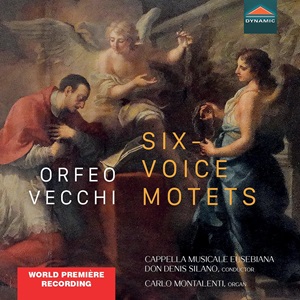
Orfeo Vecchi (c.1551-1603)
Six-Voice Motets (Milan,1598)
Carlo Montalenti (organ), Cappella Musicale Eusebiana/Don Denis Silano
rec. 2023, Cappella del Seminario Arcivescovile,Vercelli, Italy
Dynamic CDS 8001 [66]
The Vecchi you may have met would be Orazio (1550-1605), a composer of sometimes racy madrigals. This is Orfeo, an exact contemporary. Filippo Picinelli’s booklet notes, which I will quote with thanks, say that he “stands out as a figure […] worthy of special attention in the realm of sacred renaissance Italian music”. He appears to have written little else. This may be the first ever disc devoted to his music. It concentrates on one publication, Motectorum sex vocibus liber tertius, and we hear all of its twenty works.
Orfeo was “endowed with such brilliance of wit and quickness of hand that […] he could compose a motet” in a short time. Not surprisingly, then, he seems to have been prolific. Most of his music was published not only in his lifetime but in later anthologies, and also re-printed. He worked for a time in Vercelli in northern Italy, but moved on to greater things in Milan, some sixty miles away, where he lived out his life.
Monsignor Denis Silano, who directs these performances, writes that the passages a voce piena in the form of refrains and in ternary time bring the author close to what would become customary in the early 17th-century form of the concertato motet. He also notes that there is much cori spezzati as in the opening Consolamini popule meus.
The question arises why we are so unaware of Orfeo Vecchi’s music. I have no answer, and I am not sure these worthy performances can help much either. But take the music in small amounts, and it will surely grow on you. The choir, which sounds quite unlike an English college choir, will probably grow on you too. Even so, their forthright open vowels and often penetrating inner parts may sound a little rough at times. They also judiciously employ vibrato. There are, if the photograph is representative, thirteen voices, of whom only two are women, as there are a number of pieces just for lower voices. To me, the best and most expressive performances are when the women are singing, as in the rather madrigalian Virgo prudentissima. The organ frequently doubles the vocal parts, adding some pleasing colour. It seems that Milan in the 16th century had a group of instrumentalists who might well have doubled the singers.
The texts are very varied, and the programme offers a variety of moods and words as dictated by the differing seasons of the church. For example, a lively, troped setting of the Gloria is immediately followed by a text from the Song of Songs, Veni dilecte mi. There follows one of the darker psalm settings, Deus in adiutorium meum intende; sadly, we are never told the source of each text. Christmas and Easter texts are represented, and there is even one in honour of St. Francis, Coelorum candour splenduit. Vecchi has a very winning way of sometimes repeating a line within the text. For example, in Mulier quid ploras the men ask ‘Woman why are you crying’ and the upper voices answer ‘because they have taken my Lord away’.
If you are prone to exploring the highways and byways of late-renaissance sacred music, then this disc would be of interest. There is some very beautiful singing, but how often you might play it is another matter.
Gary Higginson
Buying this recording via a link below generates revenue for MWI and helps us keep free access to the site



Contents
Consolamini popule meus
Prudentes virgins
Virgo prudentissima
Surrexit pastor bonus
Deus in n omine tuo
Vide Domine
Quem visitis pastores?
Quem quaeris Magdalena
Gloria in excelsis Deo
Veni dilecte mi
Hodie lucerne
Deus in adiutorium
Eructavit cor meum
Maria Magdalena [prima pars]
Et valde mane [secunda pars]
Coelorum candour splenduit
Alleluia, Christus resurgens
Aspice Domine
Ardens est [prima pars]
Mulier quid ploras? [secunda pars]

















